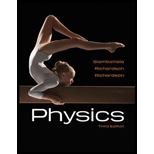
(a)
The effective spring constant of the combination.
(a)
Answer to Problem 126P
Theeffective spring constant of the combination is
Explanation of Solution
Imagine that spring (1) is suspended from a ceiling and spring (2) is attached to the bottom of the first spring. An object of mass
Write the Hooke’s law for the spring (1).
Here,
Rewrite the above equation for
Write the Hooke’s law for the spring (2).
Here,
Rewrite the above equation for
Assume that the masses of the springs are negligible and the system is in equilibrium. The mass connected to the spring (2) exerts a force on the lower spring equal to its weight.
Here,
Put the above equation in equation (IV).
Write the equation for the force the lower spring exerts on spring(1) .
Put the above equation in equation (II).
Put equation (V) in the above equation.
Compare equations (II) and (VII).
Put equations (I) and (III) in the above equation.
Take
Put equations (II) and (IV) in the above equation.
Rewrite the above equation for
Conclusion:
Therefore, the effective spring constant of the combination is
(b)
The potential energy stored in the spring.
(b)
Answer to Problem 126P
Thepotential energy stored in the springis
Explanation of Solution
Write the equation for the potential energy stored.
Here,
In part (a), it is found that the expression for
Substitute
Conclusion:
Given that the value of
Substitute
Therefore, the potential energy stored in the spring is
Want to see more full solutions like this?
Chapter 6 Solutions
Physics - With Connect Access
 College PhysicsPhysicsISBN:9781305952300Author:Raymond A. Serway, Chris VuillePublisher:Cengage Learning
College PhysicsPhysicsISBN:9781305952300Author:Raymond A. Serway, Chris VuillePublisher:Cengage Learning University Physics (14th Edition)PhysicsISBN:9780133969290Author:Hugh D. Young, Roger A. FreedmanPublisher:PEARSON
University Physics (14th Edition)PhysicsISBN:9780133969290Author:Hugh D. Young, Roger A. FreedmanPublisher:PEARSON Introduction To Quantum MechanicsPhysicsISBN:9781107189638Author:Griffiths, David J., Schroeter, Darrell F.Publisher:Cambridge University Press
Introduction To Quantum MechanicsPhysicsISBN:9781107189638Author:Griffiths, David J., Schroeter, Darrell F.Publisher:Cambridge University Press Physics for Scientists and EngineersPhysicsISBN:9781337553278Author:Raymond A. Serway, John W. JewettPublisher:Cengage Learning
Physics for Scientists and EngineersPhysicsISBN:9781337553278Author:Raymond A. Serway, John W. JewettPublisher:Cengage Learning Lecture- Tutorials for Introductory AstronomyPhysicsISBN:9780321820464Author:Edward E. Prather, Tim P. Slater, Jeff P. Adams, Gina BrissendenPublisher:Addison-Wesley
Lecture- Tutorials for Introductory AstronomyPhysicsISBN:9780321820464Author:Edward E. Prather, Tim P. Slater, Jeff P. Adams, Gina BrissendenPublisher:Addison-Wesley College Physics: A Strategic Approach (4th Editio...PhysicsISBN:9780134609034Author:Randall D. Knight (Professor Emeritus), Brian Jones, Stuart FieldPublisher:PEARSON
College Physics: A Strategic Approach (4th Editio...PhysicsISBN:9780134609034Author:Randall D. Knight (Professor Emeritus), Brian Jones, Stuart FieldPublisher:PEARSON





